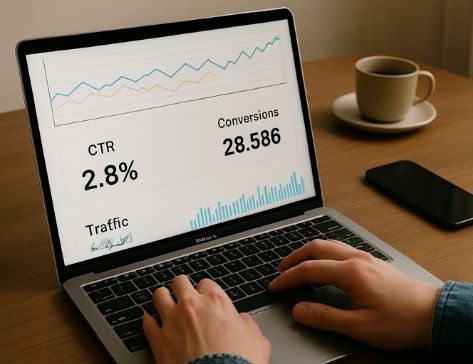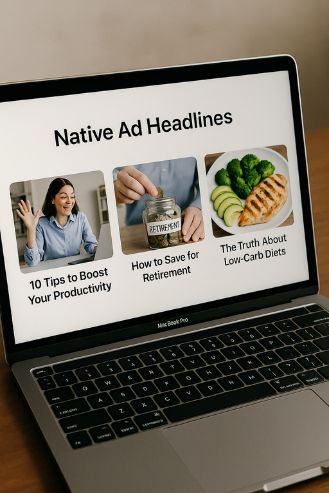
Native Ad Headlines That Convert: A Practical Guide to Higher CTRs and Conversions
Native ad headlines that convert don’t happen by accident—they emerge from a repeatable process that blends psychology, audience insight, and relentless testing. If you’ve ever wondered why some simple, almost obvious headlines spike click‑through rates while others fizzle, the difference usually lies in structure, clarity, and the promise embedded in just a few words.
Before you write a single word, study what consistently performs in your market. Scan winning ads, look for recurring patterns, and reverse‑engineer how they create curiosity without resorting to clickbait. For a quick primer on what makes attention‑grabbing lines work, this overview of tips for killer headlines distills several proven tactics you can adapt for native placements.
Great native ad headlines respect the “native” context—meaning they feel like editorial content while signaling a clear benefit. Your job is to bridge a user’s passive browsing mood and an action‑oriented click. That bridge is built with specificity (numbers, time frames, outcomes), relevance (audience language and intent), and credibility (proof, qualifiers, or risk‑reducers).
Think cross‑channel, too. Strong creative strategy compounds when headlines align with your onsite messaging, email subject lines, and push notifications. If you’re orchestrating campaigns across formats, explore how combining native ads and push campaigns can accelerate consistency and conversions across the journey.

Why Native Ad Headlines Matter More Than You Think
Your headline is the single highest‑leverage element in a native ad. It determines whether your image and description ever get a chance. A 10–20% lift in headline CTR can cascade into cheaper traffic, more test velocity, and ultimately a stronger optimization loop. Because native inventory can vary in quality, your headline also acts as a filter—attracting the right clicks (buyers) and discouraging the wrong ones (bouncers).
The Psychology Behind Clickable Headlines
- Curiosity with clarity: Tease a gap in knowledge but promise a concrete payoff.
- Specificity: Use numbers, time windows, quantities, or constraints to anchor expectations.
- Relevance: Mirror the audience’s vocabulary and current pain points or aspirations.
- Authority: Add proof (data, expert, brand, volume) to reduce perceived risk.
- Novelty: Introduce a fresh angle or unexpected mechanism to re‑energize a crowded niche.
7 Proven Headline Frameworks for Native Ads
- Numbered List: “7 Tiny Morning Habits Top Designers Swear By”
- How‑To: “How to Cut Subscription Costs Without Downgrading Your Lifestyle”
- Question: “Paying More Than $89/Month for Home Internet? Try This Instead”
- Contrarian: “Stop Meal Prepping: This 10‑Minute Alternative Saves More Time”
- Curiosity + Mechanism: “The ‘Pocket Rule’ That Helps Parents Reduce Toy Clutter”
- Outcome + Timeframe: “Organize 1 Year of Photos in 30 Minutes—Here’s How”
- Social Proof: “Why 47,000 Gardeners Switched to This Soil Trick”
Each framework is a template, not a crutch. Swap in your audience’s language, add a fresh mechanism, and make the promise tangible. Aim for clarity first, cleverness second.
A Repeatable Step‑by‑Step Process
1) Define the click payoff
Ask: What exactly will the user learn, get, or do after the click? Write it in one sentence. If you can’t write it plainly, the headline can’t either.
2) List three audience segments
For each segment (e.g., beginners, switchers, veterans), write the pain point in their words. Headlines that convert often mirror a segment’s phrasing and mental model.
3) Draft 15–25 headlines
Use multiple frameworks. Vary the specificity (numbers, time), mechanism (tool, method), and appeal (save money, avoid risk, gain status). Don’t judge while drafting—speed wins.
4) Score with a simple rubric
- Clarity (0–3): Is the payoff unmistakable?
- Specificity (0–3): Are there concrete details (quantity, timeframe, qualifier)?
- Relevance (0–3): Does it speak the segment’s language?
- Credibility (0–3): Does it avoid hype and include proof or constraints?
5) Pre‑qualify the click
For paid traffic, you want the right curiosity—not blind curiosity. Add qualifiers like “Without X,” “For First‑Time Buyers,” or “If You Spend Over $100/Month,” so the click comes from an aligned prospect.
6) Test in batches
Launch 3–5 headlines per creative set. Use the same image to isolate the headline variable, then rotate images after you find headline winners. Keep budgets even until a clear winner emerges.
7) Analyze by quality, not just CTR
Track CTR, but also CVR, cost per add‑to‑cart, and ROAS. A headline that pumps cheap clicks but attracts poor‑fit traffic will cost more down‑funnel. Score creatives on qualified metrics.
Voice, Tone, and Compliance Considerations
Native platforms prefer editorial tone and dislike exaggerated claims. Use benefit‑forward language but avoid absolute guarantees. Add softeners like “can,” “may,” or “often” when needed. If you reference numbers, be ready to substantiate them on the landing page. Consistency between headline, image, and page hero copy reduces bounce and flags.
Optimization Tactics Most Advertisers Skip
- Front‑load the benefit: Put the outcome within the first 4–6 words.
- Use brackets: Add credibility tags like [Study], [2025 Guide], or [Case Study].
- Contrast words: Try “Instead,” “Even If,” “Without,” to reframe status quo.
- Time anchors: Insert timeframes like “in 10 Minutes” or “This Week.”
- Mechanism labels: Name the method: “The 3‑Folder Rule,” “The 5‑Minute Audit.”
- Qualifiers: Call your audience explicitly: “For First‑Time Landlords.”
Examples by Vertical
E‑commerce
- “Stop Overpaying for Razors: This $7 Handle Lasts 3x Longer”
- “These 9 Pantry Upgrades Cost Less Than $25—#6 Fixes Clutter Fast”
Personal Finance
- “Side Hustle Math: Turn 5 Hours/Week Into $300 With This Simple Tactic”
- “Pay Less for Car Insurance Without Switching Providers—Here’s How”
Health & Fitness
- “Walking Wrong? The 12‑Minute Fix That Helps Your Back Feel Better”
- “Diet Plateau? Try This 3‑Ingredient Lunch for the Next 7 Days”
Turning Winners into Systems
Create a swipe file of your own successes. Tag each winner by framework and audience segment. Every week, spin 5–10 new variants by swapping numbers, mechanisms, or qualifiers. This compounding approach steadily raises your baseline and reduces “stall” periods.
Measurement and Iteration
For quick reads, a simple rule works: if a headline’s CTR beats control by 20% with similar CPC after 500–1,000 impressions, promote it to a broader test. For deeper rigor, run tests to practical significance: ensure each variant has enough clicks to compare conversion rates with confidence, and remember to re‑validate winners when audiences or seasons change.
Common Mistakes to Avoid
- Over‑curiosity: Teasing without payoff leads to bounces and platform scrutiny.
- Vagueness: “Amazing Trick” without specifics feels like clickbait.
- Mismatch: Headline promises that the landing page can’t keep.
- Neglecting the image: If the image conflicts with the headline’s promise, results suffer.
- Testing too slowly: One headline change per month won’t reveal patterns.
Final Pre‑Launch Checklist
- Does the headline state a clear payoff in the first 6 words?
- Is there a number, timeframe, or mechanism to add specificity?
- Does it pre‑qualify the click with a relevant audience or condition?
- Is the tone editorial, not salesy, to suit native placements?
- Does the landing page reinforce the same promise above the fold?
- Do you have 3–5 alternates prepared for the first test batch?
Conclusion
Native ad headlines that convert are the product of process, not luck. Start by clarifying the payoff, speak your audience’s language, and prove your promise with specifics. Then iterate quickly and promote winners. If you need ideas to spark your next batch, browse competitive intelligence tools like Anstrex Native Ads and build a living swipe file that you revisit weekly. Over time, you’ll develop a signature voice—and a dependable system—for writing headlines that consistently attract the right clicks.


